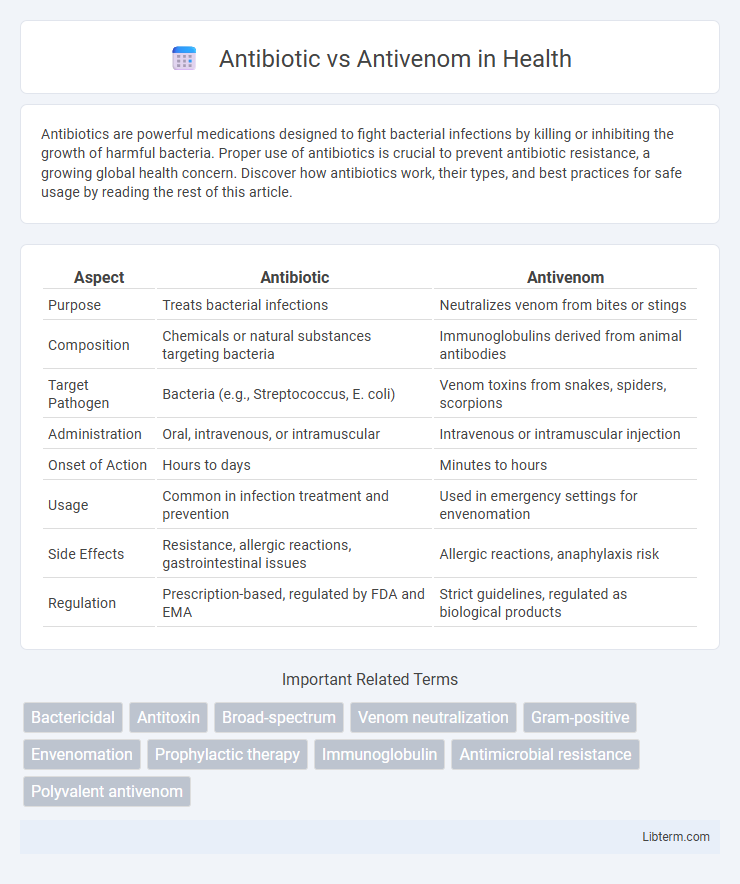Antibiotics are powerful medications designed to fight bacterial infections by killing or inhibiting the growth of harmful bacteria. Proper use of antibiotics is crucial to prevent antibiotic resistance, a growing global health concern. Discover how antibiotics work, their types, and best practices for safe usage by reading the rest of this article.
Table of Comparison
| Aspect | Antibiotic | Antivenom |
|---|---|---|
| Purpose | Treats bacterial infections | Neutralizes venom from bites or stings |
| Composition | Chemicals or natural substances targeting bacteria | Immunoglobulins derived from animal antibodies |
| Target Pathogen | Bacteria (e.g., Streptococcus, E. coli) | Venom toxins from snakes, spiders, scorpions |
| Administration | Oral, intravenous, or intramuscular | Intravenous or intramuscular injection |
| Onset of Action | Hours to days | Minutes to hours |
| Usage | Common in infection treatment and prevention | Used in emergency settings for envenomation |
| Side Effects | Resistance, allergic reactions, gastrointestinal issues | Allergic reactions, anaphylaxis risk |
| Regulation | Prescription-based, regulated by FDA and EMA | Strict guidelines, regulated as biological products |
Introduction: Understanding Antibiotics and Antivenoms
Antibiotics are powerful medications designed to treat bacterial infections by targeting and eliminating harmful bacteria within the body. Antivenoms are specialized biological products created to neutralize venom toxins injected by venomous animals such as snakes, spiders, and scorpions. Understanding the distinct purposes and mechanisms of antibiotics and antivenoms is crucial for effective treatment of bacterial infections and venomous bites or stings.
What Are Antibiotics?
Antibiotics are substances used to treat bacterial infections by killing bacteria or inhibiting their growth, targeting specific cellular processes unique to bacteria. They are ineffective against viral infections and do not neutralize toxins produced by venomous animals. Unlike antivenoms, which are antibodies designed to counteract venoms, antibiotics specifically combat infections caused by bacteria.
What Is Antivenom?
Antivenom is a specialized biological product used to counteract the effects of venom from snake bites, scorpion stings, or other venomous creatures. It is produced by immunizing animals such as horses or sheep with small, non-lethal doses of venom, then extracting and purifying the antibodies generated in response. Unlike antibiotics that target bacterial infections, antivenom neutralizes specific toxins in venom to prevent or reduce tissue damage and systemic effects.
Mechanisms of Action: How Antibiotics Work
Antibiotics work by targeting specific bacterial processes such as cell wall synthesis, protein production, and DNA replication, effectively killing or inhibiting bacterial growth. They disrupt essential functions unique to bacteria, ensuring minimal effects on human cells. Unlike antivenoms, which neutralize toxins from venomous animals, antibiotics are exclusively designed to combat bacterial infections through selective biochemical interference.
Mechanisms of Action: How Antivenoms Work
Antivenoms function by neutralizing venom toxins through specific antibodies that bind to and inactivate venom components, preventing them from interacting with cellular targets. This immunological response facilitates venom elimination from the body, reducing tissue damage and systemic effects. Unlike antibiotics, which target bacterial structures or metabolic pathways to inhibit or kill pathogens, antivenoms directly counteract venom's toxic effects without antimicrobial activity.
Medical Applications: When to Use Antibiotics
Antibiotics are prescribed to treat bacterial infections by targeting and inhibiting bacterial growth or killing bacteria directly, making them essential in managing diseases like pneumonia, urinary tract infections, and sepsis. Antivenoms, however, are specifically used to neutralize venom toxins injected by bites or stings from venomous animals such as snakes, spiders, and scorpions, and are ineffective against bacterial infections. The medical application of antibiotics is critical in cases of confirmed or suspected bacterial infection, whereas antivenoms are reserved exclusively for envenomation cases to prevent systemic toxicity and organ damage.
Medical Applications: When to Use Antivenom
Antivenom is specifically used to neutralize venom toxins from snake bites, spider bites, or other envenomations, providing an immediate immune response to counteract the venom's effects. Antibiotics are ineffective against venom and are only appropriate for treating or preventing secondary bacterial infections following an envenomation injury. Prompt administration of antivenom is critical in medical emergencies involving venom exposure to prevent systemic toxicity and tissue damage.
Side Effects and Risks of Antibiotics
Antibiotics, commonly used to treat bacterial infections, can cause side effects such as allergic reactions, gastrointestinal issues like diarrhea, and the risk of antibiotic resistance due to misuse or overuse. In contrast, antivenoms are specific immunoglobulins used to neutralize venom from snake bites or insect stings, with their own risk profile including allergic reactions and serum sickness but do not contribute to microbial resistance. Understanding the distinct side effects and risks of antibiotics is critical for appropriate treatment decisions and minimizing health complications.
Side Effects and Risks of Antivenoms
Antivenoms, derived from animal antibodies, pose risks such as allergic reactions, including anaphylaxis and serum sickness, which can occur due to hypersensitivity to foreign proteins. Side effects may also include fever, rash, and swelling at the injection site, highlighting the importance of medical supervision during administration. Unlike antibiotics, which target bacterial infections with relatively predictable side effects, antivenom usage requires careful monitoring to manage potentially severe immune responses.
Future Perspectives: Innovations in Antibiotic and Antivenom Treatment
Advancements in antibiotic development focus on combating resistant bacterial strains through novel mechanisms such as phage therapy and antimicrobial peptides, enhancing efficacy where traditional antibiotics fail. Innovations in antivenom treatment prioritize recombinant DNA technology and synthetic antibody fragments to improve specificity, reduce allergic reactions, and enable scalable production. Integrating nanotechnology and personalized medicine holds promise for both antibiotics and antivenoms, optimizing targeted delivery and patient outcomes in the future.
Antibiotic Infographic

 libterm.com
libterm.com